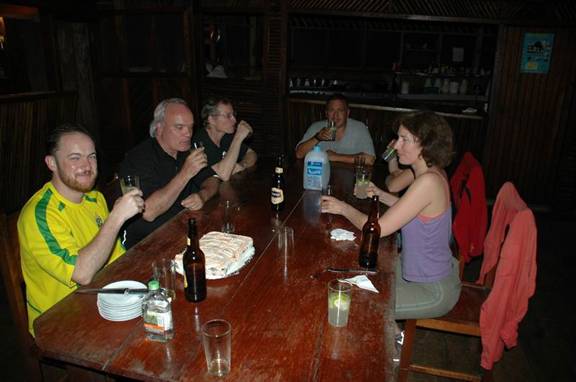An early start, February 1:
A gentle knocking at the door wakes me from a light sleep. Its 4am, we are going out early to see the parrot salt lick. Still dark, once again the head lamps come out. Ferried across the main river by canoe, it’s a pre coffee bleary eyed scramble up the muddy bank – bird song is incredibly dense and intense just before sunrise. Warm enough for shorts and T shirts but most of us wear long pants and long sleeves ‘just in case’ (in case of what I wonder? What a chicken shits). It too dark to see the trail, the rubber boots provide a bit of protection from the deeper puddles, twigs and other unmentionables lurking in the mud.
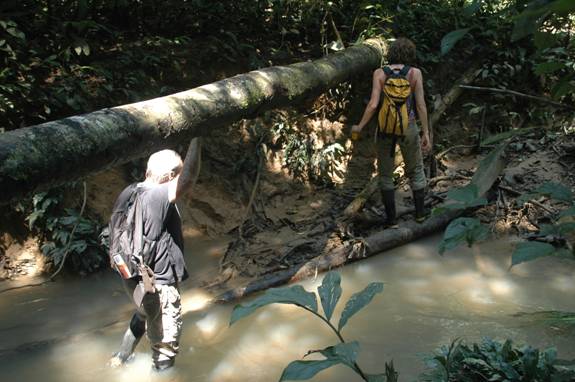
Compared to yesterday’s mellow level walk, this trail is either going up or down. I alternate between slithering down mud or using all fours to clamber up a slope. At the bottom of these gullies, water of various depths flows – happily, none tops the boots.
In the far distance, woolly monkeys tease us from the trees. A typical obstructed forest view, I ponder the patience of wildlife photographers, waiting for that perfect shot. However, my binoculars do the job well enough: their dense grey fur, thick bushy tails and movement in the trees readily apparent. They shake the branches, hooting, trying to discourage our intrusion – a few pieces of fruit are lobbed in our direction but none make contact. A baby clings to an adult’s back – Julio says it’s the male woolly monkey that does this. Later I read that the meat of woolly monkeys are considered the best tasting of meat of Amazon monkeys…
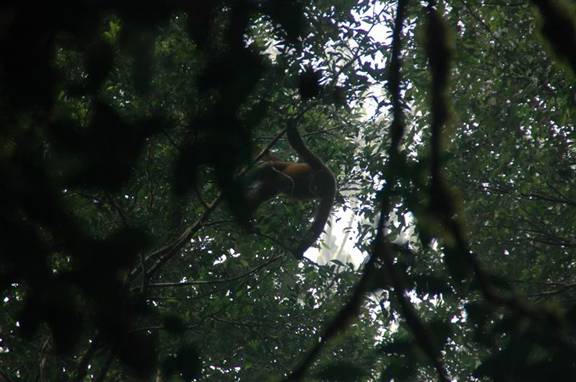
Huge mahogany trees loom from the forest floor. Julio estimates some of the largest to be 900 years old – their great size and lucrative value make them a favourite target of the lumber poachers. The large ribbed roots anchor the tree firmly in the rich soil, spreading out in all directions and going a long way from the main trunk.
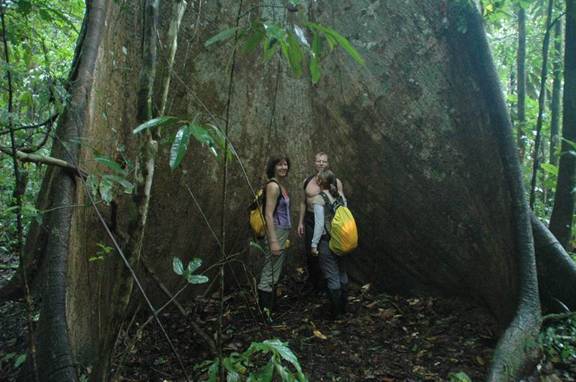
Another species of tree is used by the Indians as a drum and communication tool. By pounding on the trunk, the sound carries for 1 or 2 kilometers through the jungle despite the dense vegetation.
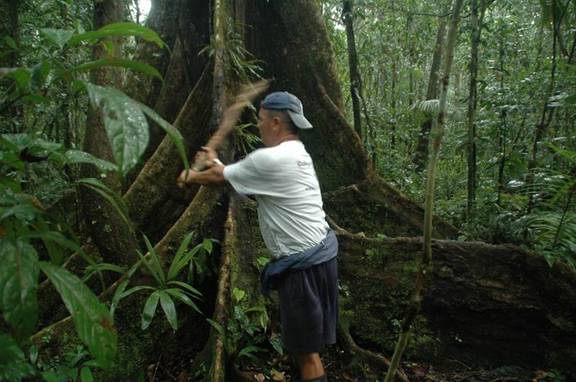
The huge diversity of plant and animal life is apparent to even the most casual observer. Leaves, trunks, colours, smells, sounds and shapes - a seemingly wild mix but on closer inspection, a highly structured community with its own law and order.
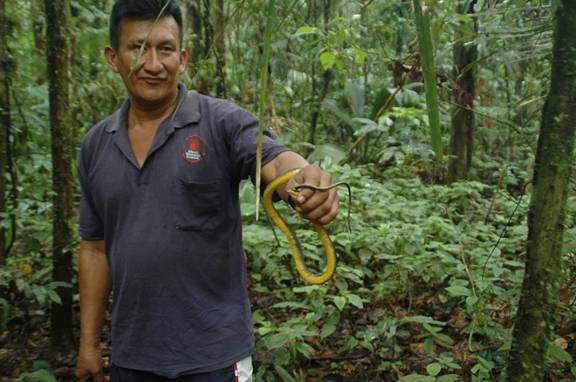
Finally the salt lick. It’s a clay bank, under cut to the side of a hill. Water dribbles along the forest floor, filling the tracks of a large three toed tapir and peccary (smaller cloven hoof). Julio and Fausto excitedly motion us to be quiet in the hopes we might spot one of these shy creatures. But we see no animals or birds – after 15 minutes of relative silence (jeez gang! shut up), some people are ready to return for breakfast. Returning to the river by a more direct route, a welcome breakfast of coffee and pancakes are hastily consumed with appetites sharpened by the morning walk.
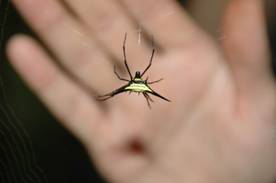
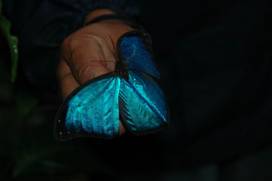
At 9:30am, the sun is up over the tree tops, a pale yellow disk, diffuse instead of burning rays. The wind is less than dead calm and the humidity builds, pressing against my face like a feather pillow, suffocating still, deadening senses. I move in slow motion, lead like limbs, fingers swelling with heat.
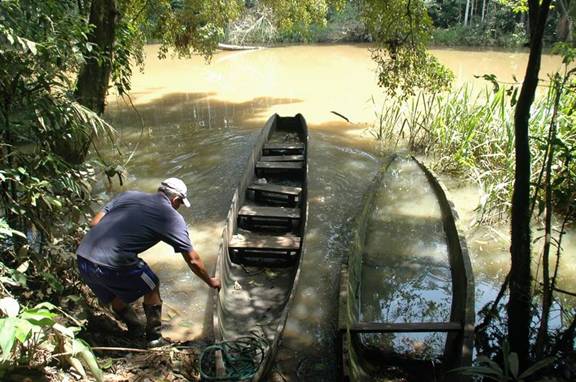
At the end of a short path, a tiny pond with 2 water filled dugout canoes wait to be bailed. The intent is to fish for piranha and look for an anaconda seen in the area a few days ago. The dugouts are perfect craft for the jungle, not prone to rot (or at a slow pace), sturdy, stable and adaptable for many uses. The larger slimmer dugout shows its makers marks, gouges from wood chisel like fish scales. The other canoe is broader, has fixed plank seats, the body constructed from strips of smooth planks: rusting nails protrude in splinted gunnel gaps.
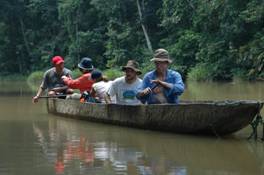
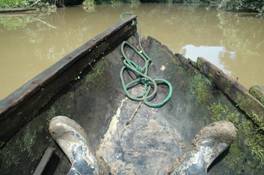
Bailing is quick work with a cut off javex bottle, In the dugout, five of us sit comfortably on tiny wood benches elevated about the damp bottom. In the plank canoe, four people rest on free floating planks. Fausto wields the paddle (carved from a single wood plank, heavy and cumbersome) with little apparent effort.
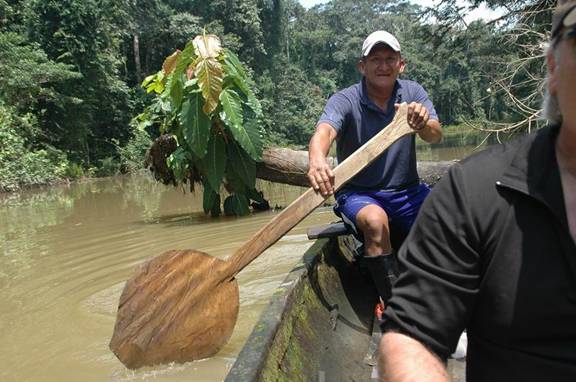
Hooks are dutifully baited and dropped along side. It is hot and my interest in fishing is tepid. I drift off, stupefied by the heat, lulled by jungle sounds. A sharp tug on my line, and too late, I lift the line, the chicken bait neatly removed. Another chunk on the hook, my attention perked now that I’m assured fish lurk below in the murky water. No one else has caught anything yet but the bait is disappearing at a steady pace. Another tug on my line, the fish got it again! Julio clucks his tongue and continues to offer hints.
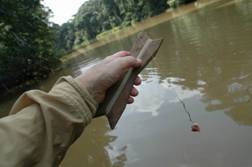
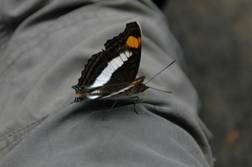
Slowly, we circumnavigate the still pond, lines trailing the water. A butterfly seeking moisture lands on my pant leg before leisurely lifting off. Julio stops, mid paddle stroke, water drops disturbing waters mirror surface. ‘Shhhhhh!” and points ahead – all eyes follow his arm, fishing forgotten. ‘Anaconda in the tree…see?” Those words have our undivided attention, all chatter immediately stops. Just above the waterline, coiled in the base of a tree, a glossy black band the size of my thigh, lies still. Silky smooth all over, the patterned underbelly with black circles, orange daubs, the snake blends with the mottled forest understory.
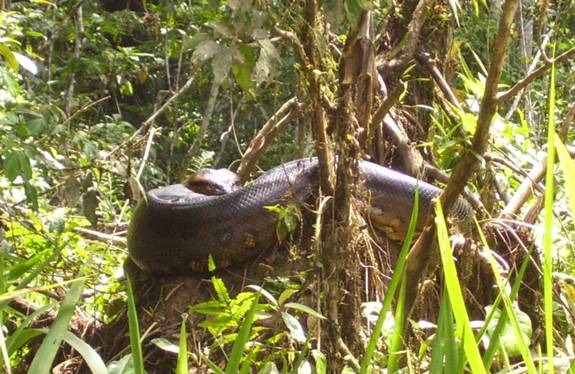
With the help of binoculars, I zoom in. Black glittering eyes and aggressive diamond shape head startle me. That creature is well aware of our presence 10’ away, watching with interest but not yet alarmed. How wonderful to view a snake in its natural environment doing what snakes do! I’m thrilled... Silently, Julio back paddles our canoe so the other group can also have a look.
Well, with such an exciting sight, fishing pales – we paddle back to shore, leave the canoe, walk back along the path to the main river, get in the large steel sided canoes and power upstream to a river side lunch spot. Talk is all about the snake, a thousand and one questions! Patiently, Julio and Fausto field our queries.

shore lunch – getting into the boat without bringing a lot of mud is a challenge
A sudden thundershower catches us on the 90 minute journey upstream, to the lodge. I’m hoping for some temperature relief, but unlike northern latitudes where summer storms often clear the humidity, the air remains saturated. The sun comes out, burning off thin clouds that drape the tree canopy, adding to the stifling discomfort – I’m glad to take shelter in the shade of the thatched roof back at the lodge.
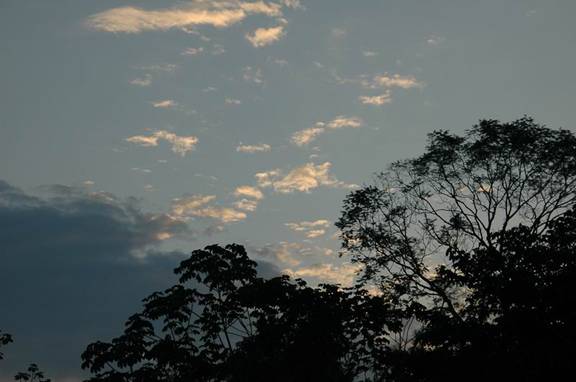
The evening plan is to search for caimens in the main river. Well, using the ever handy headlamp, I’ve been snooping around the lodge grounds in the evening myself, finding the beady eyed reptiles behind the kitchen in a small lagoon. Feeling lazy, I’m not keen on getting in the boat again. Maybe there are really BIG ones (can grow up to 16 plus feet)? Part of the alligator family, they are a fresh water species that like much of other Amazon wildlife, suffers from habitat loss, poaching and other population stresses.
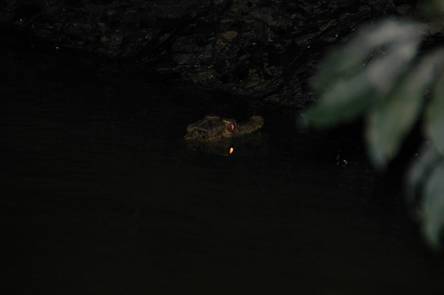
Engine trouble starts almost immediately – Fausto fiddles with what ever, Julio uses the paddle to keep the boat from crashing into the understory along shore. Ralph and Peter are not impressed, swatting at unidentified insects. Julio seems intent on finding and wrestling a caimen into the boat – our group is not interested in such ‘man-ly’ exploits and is happy to observe the wildlife in an unmolested state. Hmmm, maybe too much Crocodile Dundee influence here.
Eventually the motor starts – it’s a beautiful night regardless, an almost full moon peeping out from puffy clouds, the belt of Orion clearly visible, almost directly overhead. We motor back to the lodge where the cook has prepared a birthday cake for the three of us born within 10 days (and many years apart). As the ‘middle’ child, Ralph gets the honour of doling out the pieces – a few cervesas and recap of the day, I’m ready for bed.
